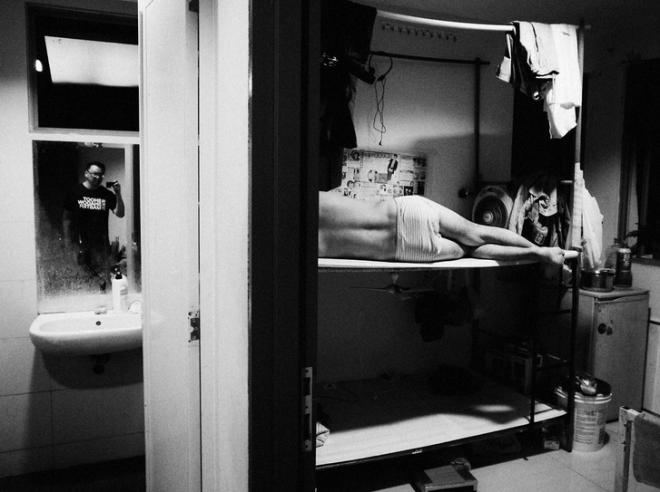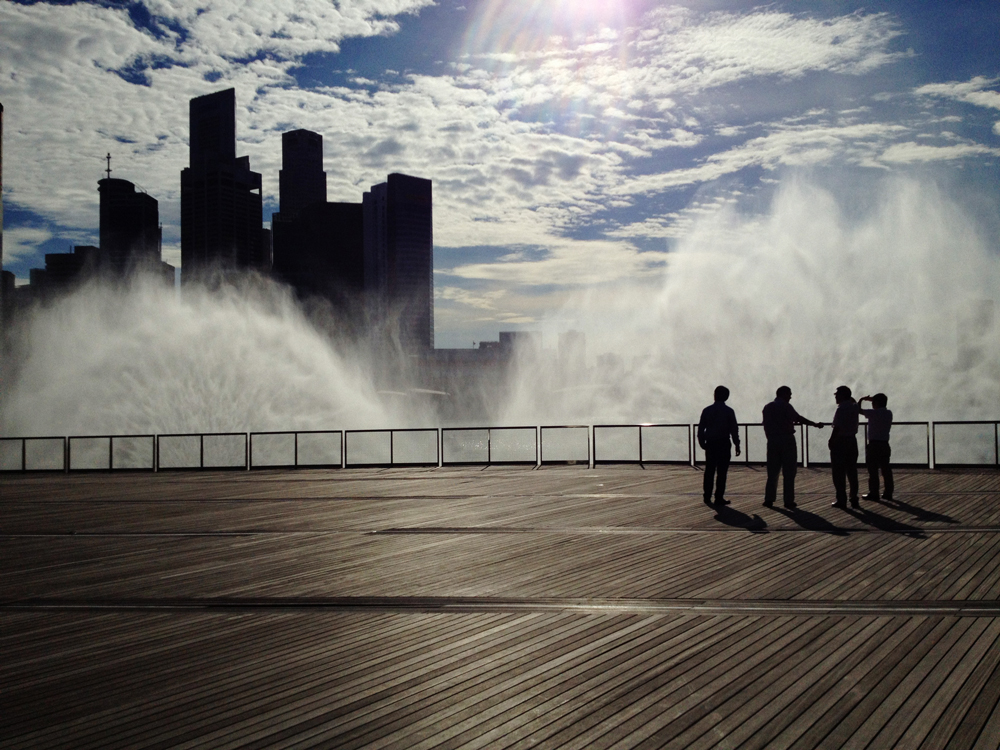Eric’s Note: Aik Beng Chia (ABC) is a street photographer based in Singapore. I first met him a few years back, and he is one of the hardest working and humble street photographers I know. He has recently published, “Tonight The Streets Are Ours” with Invisible Photographer Asia. To check out what he has been up to, read the interview below!
1. Great to have you again ABC. Tell us more about your personal background and how you discovered photography.

Thanks Eric, glad to be back. I was born and raised in Singapore, and work as a designer in a digital-centric global advertising agency. My free time is spent with my family at home, and with my cameras on the streets of Singapore.
I discovered photography in 2008. Back then i didn’t have a camera except an iPhone. I started taking random candid snaps, but in late 2009 i began to take photography seriously. I’ve been actively shooting for almost three years mainly on a mobile phone, and more recently, digital and film cameras.
I’m still discovering photography from both local and international photography communities.
2. By trade you work in graphic design, and your work is quite incredible. I can see much of your discipline in form and composition in your photography as well. But photography is much more instantaneous whereas design is much more premeditated. How do you balance both planning your shots and shooting with intuition on the streets?

My training as a designer somehow helps me with the way I look at things that surrounds me. Planning and shooting with intuition needs to be balanced. I frame instinctively, and the discipline in form & composition just comes naturally to me when I’m on the streets.
It’s both good and bad; good as that discipline forces me to be more attentive towards composition & aesthetics, but bad in that the photos I take turns out to be too ‘Pretty’. Right now, I’m trying to break away from that habit and explore other options to see if my work can be more “raw.”
3. You shoot street photography primarily with your iPhone. I think your work speaks for itself, in the sense that to a certain extent, “the gear doesn’t matter”. However there are downsides to the iPhone for street photography such as the image quality in high isos as well as perhaps the handling. What has been your experience shooting with compact cameras, and why do you stick with mobile phones for street photography?

Yes the mobile phone’s camera has its limitations, but despite the downsides (such as the image quality) I don’t see any issue with it. To me, ultimately, it is the photo that matters.
As for the handling, every camera has pros and cons, i like to use the limitation to my advantage for both compact cameras & mobile phones. I use my iPhone or Android phones because it is less intimidating when comes to street photography.
3a) You used to shoot prolificly on your iPhone, but recently have been shooting more with your Ricoh GXR. Can you share why the shift and how it influences how you shoot on the street in a different way?

I think a mobile phone camera is a good way to start learning, exploring and understanding photography for those who are new. You can still take a good photo and tell a story with it.
Having used an iPhone for the past few years, I just felt it’s time to move on and try other cameras, so i chose a Ricoh GXR with a 50mm-equivalent lens. The difference between them is the working distance, as I’m forced to be closer to my subjects or surroundings with an iPhone, but with a Ricoh GXR I don’t have to be that close.
4. You are quite active in the Singapore street photography scene and also a part of the new collective there, “5ive Foot Way”. I have noticed there is also a great Renaissance of street photography in Singapore at the moment. Can you describe the scene and perhaps share why you think there is so much great work coming out of singapore?

The Street Photography scene n Singapore, is growing and becoming more popular compare to the past few years. This is largely due to local groups/communities have been actively advocating Street Photography.
Also more street photography workshops from renowned photographers like Alex Webb, David Gidson, Eric Kim, Kevin Wy Lee etc. plays a part in helping local street photographers. This has helped improved their personal bodies of work– that’s why there is good work being produced out of Singapore.
5. You had a solo exhibition in the invisible photographer Asia gallery in singapore and do lots of collaborations with them and Kevin Lee. Can you share how invisible photographer Asia and Kevin Lee have helped you in your photography?

Invisible Photographer Asia helped open my eyes to the world of Asian social documentary, street photography and visual journalism. i’m very thankful to Kevin WY Lee, founder of IPA, as he guided and helped me in my street photography journey.
I attended one of his street photography workshops recently, and learned so much from him and the other participants. Kevin also assisted me in my forthcoming photo book about Little India in Singapore titled: “Tonight the Streets Are Ours.”
6. Last year when I visited you in singapore you experimented shooting film on a Ricoh GR1s. Can you share your experiences shooting with film and how it compares to the instsntaneousness of digital and especially the iPhone?

I love the Ricoh GR1s! I like shooting film because it slows me down. I have a Leica CL now, I’m taking my time to shoot with it, as I’m still new to it. Learning to get my exposures correct is my priority now.
The experience with film and digital is very different. I like the look of the grain, the feel of film. I wish I had taken up film photography earlier, but thankfully, it’s still not too late.
7. You have published several zines of your work so far. Can you share the concept behind them and why you do it?

‘Where I Am‘ are images I took, wherever i am in Singapore. So far, three issues have been released at Magcloud.
Another project I’m working on right now is called ‘3hirty6ix’. 3hirty6ix is a photozine with 36 photos, from 36 photographers and 36 contact sheets. Think of it like ‘Magnum Contact Sheets‘, but with iPhones instead of film cameras. I am working closely with the creator of the app, Gary Cohen, to launch the photo zine.
8. There are a lot of street photographers using their iPhone and android devices to shoot street photography. What technical settings do you use, applications, external accessories, etc do you use and recommend?

For me, When comes to iPhone, my favourite apps are Procamera & Thirty Six for street photography. As for editing, I recommend Snapseed.
9. Where do you gain inspiration for your work, in terms of photography, art, film, etc?

My work is inspired by Henri Cartier-Bresson, Andre Kertesz, W. Eugene Smith, and Brassai. But my work has evolved over time.
10. Why do you shoot street photography and why is it precious to you?

Shooting street photography allows me to have personal and intimate moments in a public space. That’s precious because it allows me to know myself and my world better, it’s my quiet time, and that characterises my photography.
11. Can you tell us the story behind 3 of your most memorable shots?

I’m afraid I don’t have 3 but there’s one most memorable encounter. It is a street portrait of Mr Veerayan, a homeless man I met. During our conversation i found out that he was then recently discharged from a mental institution. He appeared to be mentally unstable.
Before I left, I asked if I could take a portrait of him, and he agreed. After the portrait was taken, he said to me, “Let me give you something in return for good luck.” I agreed, and Immediately he opened his mouth and asked me to take one of the cigarette butts inside his mouth, and swallow it.
Of course I did not take it, but he insisted. In the end I settled for a leaf he kept in his pocket.
12. What advice would you give to aspiring street photographers based on your experience?

Don’t rush, take your time to photograph things that interests you, that you feel close to, instead of what you feel you ought to do. Most importantly, shoot who you are and not what others want you to be.
Observe life in front of you, have fun and enjoy the process. Remember that Facebook “Likes” and social media now of huge “Followers” does not necessarily mean you are a good photographer.
13. Any last words you would like to mention and people you would like to give a shout out to?

Photography is 99% failure — embrace that fact because it will make you a better photographer. To the members of 5ive Foot way collective, Adam Rahim, Callan Tham, Jun Shen Chia and Tham Jing Wen. Kevin WY Lee from Invisible Photographer Asia.
Friends like Alva Oh, Kelvin Lam, Chris Lim & Kenneth Wong. Mobile Photography communities and friends both local & overseas (you know who you are). All of them have been very supportive and helped me in many ways during my journey. I am very thankful to them.
Tonight The Streets Are Ours

ABC recently published photos of the Little India neigborhood in Singapore after dusk (all shot on a mobile camera).
You can see a preview of the book here: Photo Essay: Tonight The Streets Are Ours, by Aik Beng Chia
Pick up a copy of the book on IPA here.
Publication Details


